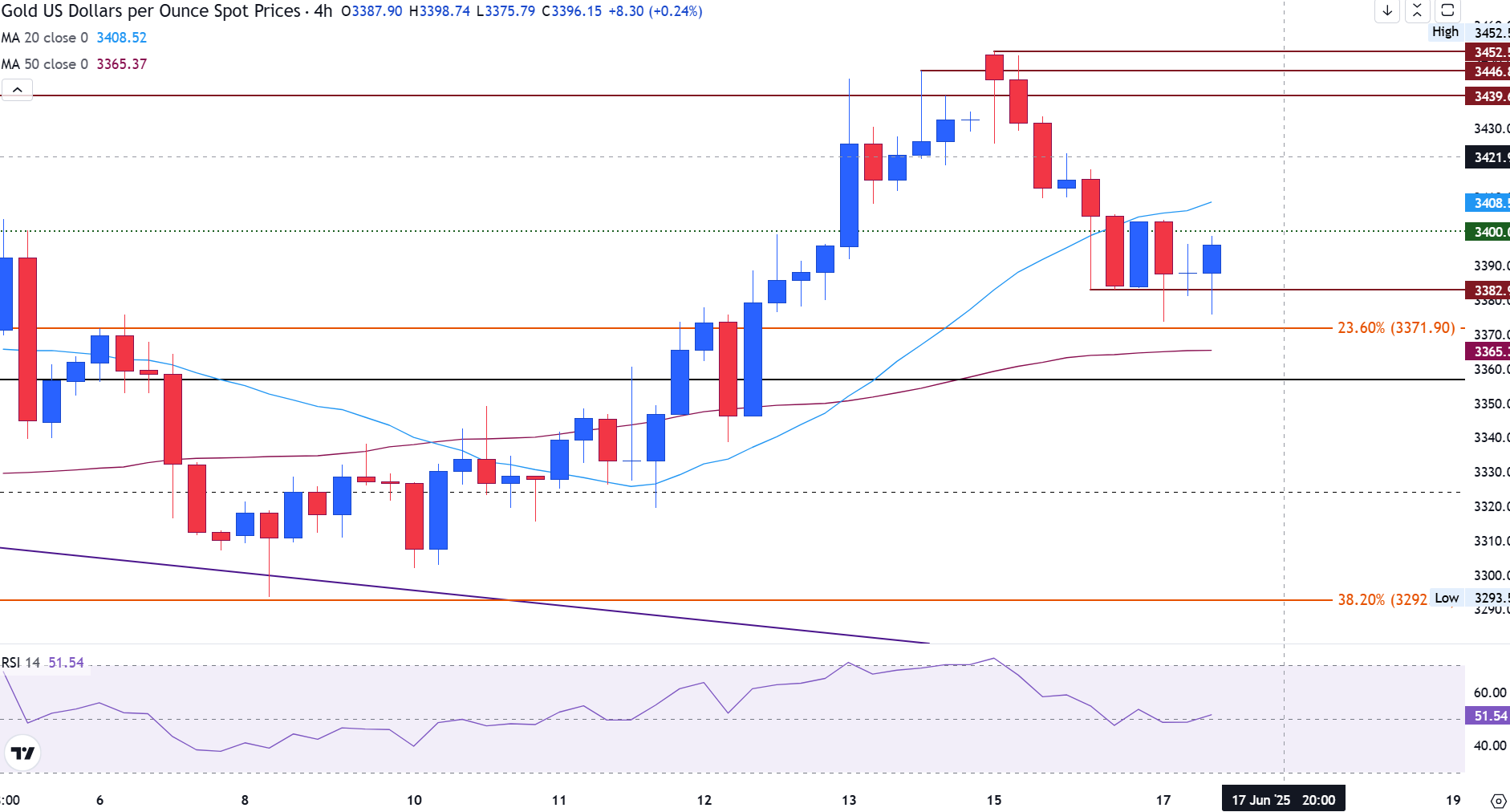Gold surges as Trump says he looks for a 'real end' to the Israel-Iran war
- Gold bulls return as geopolitical risks intensify ahead of Wednesday’s Fed interest rate decision.
- Israel-Iran hostilities rise with calls for the evacuation of Tehran, supporting safe-haven flows.
- XAU/USD nears $3,400 ahead of the US Retail Sales data release due later.
Gold moves higher against the US Dollar (USD) on Tuesday, trading around $3,395 at the time of writing, bolstered by an escalation in the Israel-Iran conflict and rising safe-haven demand.
The US President Donald Trump stated in a post on Truth Social on Tuesday: "I have not reached out to Iran for ‘Peace Talks’ in any way, shape, or form. This is just more HIGHLY FABRICATED, FAKE NEWS! If they want to talk, they know how to reach me." He added that Iran “should have taken the deal that was on the table — would have saved a lot of lives.”
Markets reacted after Trump had earlier called for Iranian citizens to evacuate Tehran, warning of further strikes. Israeli Prime Minister Benjamin Netanyahu echoed the message as Israeli airstrikes continued targeting Iranian nuclear and military sites. On Tuesday, Iran’s Revolutionary Guards confirmed new missile and drone attacks on Israeli positions. The growing risk of a full-blown regional war has sent XAU/USD climbing back toward $3,400.
Additionally, Retail Sales data from the United States (US) on Tuesday could provide an extra short-term catalyst for the precious metal. The report precedes Wednesday’s Federal Reserve (Fed) interest rate decision.
Daily digest market movers: Factors to watch for Gold
- US Retail Sales data serves as a key barometer for consumer spending, the largest contributor to US economic growth. Any downside surprise could support Gold, by reinforcing Fed dovish monetarpolicy expectations and weakening the Dollar.
- Monthy figures are expected to show a 0.7% contraction in May, following a 0.1% rise in April. The Retail Sales Control Group, which better reflects underlying consumer demand, fell by 0.2% in April, and another weak reading could reinforce the view that the US consumer is slowing.
- The Israel–Iran conflict remains a key upside risk to global inflation, particularly through its potential impact on Oil supply and shipping routes.
- A sharp escalation could drive energy prices higher, stall progress in disinflation and force central banks to keep interest rates elevated for longer. This scenario could harm Gold, with competing forces of inflation hedge and higher US yields.
- The focus on Wednesday will be on the Fed's Summary of Economic Projections (SEP) and the dot plot, which could reveal whether officials still anticipate one or two rate cuts in 2025 or scale back expectations in light of recent inflation risks.
Technical analysis: Gold bulls push back toward $3,400
On the 4-hour chart, Gold (XAU/USD) is consolidating above the $3,375–$3,380 support zone, with prices last seen around $3,394.
The 20-period Simple Moving Average (SMA) at $3,408 is capping immediate upside, while the 23.6% Fibonacci retracement of the recent rally offers support at $3,371.90. Below that, the 50-period SMA at $3,365 reinforces key demand.
A break above $3,408 could lead to a retest of the monthly highs at $3,446 and $3,452. On the downside, failing to hold $3,371 could expose a deeper retracement toward $3,292, the 38.2% Fibonacci level. The Relative Strength Index (RSI) hovers near 51, indicating neutral momentum with room to extend in either direction.
Gold 4-hour chart

Risk sentiment FAQs
In the world of financial jargon the two widely used terms “risk-on” and “risk off'' refer to the level of risk that investors are willing to stomach during the period referenced. In a “risk-on” market, investors are optimistic about the future and more willing to buy risky assets. In a “risk-off” market investors start to ‘play it safe’ because they are worried about the future, and therefore buy less risky assets that are more certain of bringing a return, even if it is relatively modest.
Typically, during periods of “risk-on”, stock markets will rise, most commodities – except Gold – will also gain in value, since they benefit from a positive growth outlook. The currencies of nations that are heavy commodity exporters strengthen because of increased demand, and Cryptocurrencies rise. In a “risk-off” market, Bonds go up – especially major government Bonds – Gold shines, and safe-haven currencies such as the Japanese Yen, Swiss Franc and US Dollar all benefit.
The Australian Dollar (AUD), the Canadian Dollar (CAD), the New Zealand Dollar (NZD) and minor FX like the Ruble (RUB) and the South African Rand (ZAR), all tend to rise in markets that are “risk-on”. This is because the economies of these currencies are heavily reliant on commodity exports for growth, and commodities tend to rise in price during risk-on periods. This is because investors foresee greater demand for raw materials in the future due to heightened economic activity.
The major currencies that tend to rise during periods of “risk-off” are the US Dollar (USD), the Japanese Yen (JPY) and the Swiss Franc (CHF). The US Dollar, because it is the world’s reserve currency, and because in times of crisis investors buy US government debt, which is seen as safe because the largest economy in the world is unlikely to default. The Yen, from increased demand for Japanese government bonds, because a high proportion are held by domestic investors who are unlikely to dump them – even in a crisis. The Swiss Franc, because strict Swiss banking laws offer investors enhanced capital protection.

